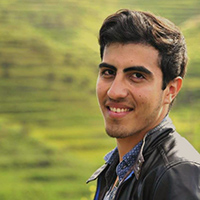SINGEK BLOG: No longer an imaginary world

Single cell genomics give us a new view of microbial diversity
Mark Twain once said, “You can’t depend on our eyes when your imagination is out of focus”. The famous writer probably had other things on his mind when he coined this phrase, but I consider it as a good starting point for the request I am about to make.
My request is rather simple, I just want you to imagine. I want to imagine a world where your eyes just perceive a small part of a bigger world around you. Imagine that you are seeing through a small hole in your door. If I ask you now to describe what you are perceiving, what apparently is just a tree from your point of view, could actually be a whole forest, and what may look as one house, may actually be an entire town.
As a scientist, I have to constantly cope with this narrow perception of the world that I am trying to understand. I work with protists, small, unicellular eukaryotes. There is an astonishing diversity of those organisms, but we can obtain information of only a few of them. Even though culturing methods have been really helpful to get a general picture of their diversity, they only provide a narrow view. This image is even more coarse grained, since cultured microbes end up becoming monoclonal. This means, we end up with clones of a single individual cell, which clearly do not represent the diversity in nature. As a rule of thumb, only about 1% of all microorganisms are currently cultivable in a laboratory environment. Hence, the hole in my door is probably even smaller than the one you just imagined.
My line of work is key to get insights into this diversity of microorganisms, to clarify the relationships between all eukaryotes, to understand their origin, and therefore, our origin. Single-cell genomics is a recent tool that is giving us an opportunity to finally access this hidden diversity. In the past, we had to culture unicellular microorganisms in a lab before we could obtain information about their DNA. With single-cell techniques we are now able to get all the information we need from only one cell, allowing us to avoid the culturing step. This gives us a view of the microbial world closer to reality.
Single cell genomics allow us to take a drop of water from any pond around the globe, separate the microorganisms it contains and classify them individually according to their genetic information. With single cell genomics, we have a tool that gives us this information from each individual, with all their diversity included. This analysis method delivers an enormous amount of new data, and a new world of possibilities for us scientists, which just makes us rub our hands.
Nevertheless, single-cell genomics still need a lot of improvement. The method of amplification of DNA introduces certain biases to the analysis. The lysis of unicellular eukaryotic cells still needs improvement, and our ability to obtain and sequence genomes is clearly behind our ability to analyse them computationally. However, there is a new generation of researchers working every day to overcome these obstacles, researchers that keep on imagining. They imagine themselves not looking anymore through that little hole, they imagine themselves opening the door and finally getting a full picture of the diversity of the world which we are part of, a diversity that we are not even able to comprehend yet.
About the author

Luis Galindo – ESR 7
I am an Evolutionary Biologist original from the Canary Islands (Spain), and I have been selected by the SINGEK training network to work in the ESR7 project in Deep Eukaryotic Phylogenomics. I obtained my biology degree from the University of La Laguna in Tenerife. During my degree, and after I graduated, I worked with the Molecular Genetics and Biodiversity research group in the IUETSPC (University Institute of Tropical Diseases and Public Health of the Canary Islands).


Leave a Reply
Want to join the discussion?Feel free to contribute!